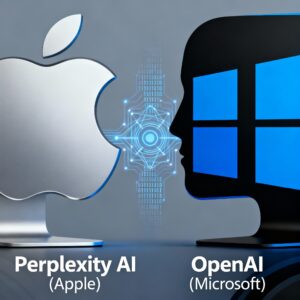Perplexity and OpenAI reflect the enduring Apple vs Microsoft divide: one leading with product clarity, the other with human narrative. Explore how AI’s new rivalry defines our cognitive era.

Every generation has its defining tech duality: a mirror of ideology as much as invention. In the 1980s, it was Apple versus Microsoft. Today, it’s Perplexity and OpenAI. Both are reshaping how we think, search, and interact with artificial intelligence, but in fundamentally different ways that echo the oldest rivalry in modern tech.
The Roots of Two Philosophies
Apple built its reputation around elegance and emotion: technology as art. Microsoft pursued practicality and universality: technology as infrastructure. They weren’t just companies in competition; they were cultures of thought.
Fast forward to 2025, and the pattern reappears. Perplexity stands where Apple once stood — leading with verified truth, design integrity, and precision of experience. OpenAI plays the Microsoft role: scaled, accessible, and personality‑driven through the prominence of its leader Sam Altman.
The Face Versus the Framework
Perplexity’s brand centers on function as trust. It doesn’t need a celebrity founder; its accuracy is its persona. OpenAI, conversely, cultivates relatability through narrative, positioning Altman as the accessible moral anchor for a vast ecosystem. One builds legitimacy through product, the other through proximity to human storytelling.
This divergence isn’t merely aesthetic — it’s philosophical. Perplexity markets truth as a process, almost journalistic in structure. OpenAI markets empathy, inviting emotional loyalty rather than logical admiration. One appeals to cognitive security, the other to creative kinship.
The Emotional Tone of Data
Apple and Perplexity turn precision into poise: they make information feel like art. Microsoft and OpenAI tether data to dialogue: they make innovation feel human. Both moves are different: but it is Perplexity that elevates. OpenAI is a cult of personality.
Innovation that uplifts clarity will always coexist with innovation that centers connection. Their balance defines how future users will build trust in AI systems.
Choosing sides between product‑driven and persona‑driven innovation reveals our emotional needs as thinkers and consumers. Some of us seek serenity in certainty; others, comfort in empathy.
If Apple vs Microsoft shaped personal computing, then Perplexity vs OpenAI defines cognitive computing. The former built the machines we touch. The latter builds the frameworks we think with.
As the world enters the era of reasoning engines and machine collaboration, one thing is clear: the future of truth will be designed not by algorithms alone, but by the stories we tell through them.